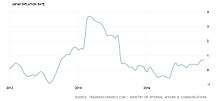Zero interest-rate policy
Zero interest-rate policy (ZIRP) is a macroeconomic concept describing conditions with a very low nominal interest rate, such as those in contemporary Japan and December 2008 through December 2015 in the United States. It has begun again in the United States since March 15, 2020; the Federal Reserve cut the Fed Funds rate to nearly zero due to the ongoing COVID-19 pandemic and weakening economy. ZIRP is considered to be an unconventional monetary policy instrument and can be associated with slow economic growth, deflation, and deleverage.[1]


Overview
Under ZIRP, the central bank maintains a 0% nominal interest rate. The ZIRP is an important milestone in monetary policy because the central bank is typically no longer able to reduce nominal interest rates—it is at the zero lower bound. Conventional monetary policy is at its maximum potential to drive growth under ZIRP. ZIRP is very closely related to the problem of a liquidity trap, where nominal interest rates cannot adjust downward at a time when savings exceed investment.
However, some economists—such as market monetarists—believe that unconventional monetary policy such as quantitative easing can be effective at the zero lower bound.
Others argue that when monetary policy is already used to maximum effect, to create further jobs, governments must use fiscal policy. The fiscal multiplier of government spending is expected to be larger when nominal interest rates are zero than they would be when nominal interest rates are above zero. Keynesian economics holds that the multiplier is above one, meaning government spending effectively boosts output. In his paper on this topic, Michael Woodford finds that, in a ZIRP situation, the optimal policy for government is to spend enough in stimulus to cover the entire output gap.[2]
Chris Modica and Warren Sulmasy find that the ZIRP policy follows from the need to refinance a high level of US public debt and from the need to recapitalize the world's banking system in the wake of the Financial crisis of 2007–2008.[3]
Zero lower bound
The zero lower bound problem refers to a situation in which the short-term nominal interest rate is zero, or just above zero, causing a liquidity trap and limiting the capacity that the central bank has to stimulate economic growth. This problem returned to prominence with the Japan's experience during the 90s, and more recently with the subprime crisis. The belief that monetary policy under the ZLB was effective in promoting economy growth has been critiqued by economists Paul Krugman, Gauti Eggertsson, and Michael Woodford among others. Milton Friedman, on the other hand, argued that a zero nominal interest rate presents no problem for monetary policy. According to Friedman, a central bank can increase the monetary base even if the interest rate vanishes; it only needs to continue buying bonds.[4]
See also
|
|
|
|
References
- Roubini, Nouriel (January 14, 2016). "Troubled Global Economy". Time Magazine. time.com. Retrieved February 5, 2016.
- Woodford, Michael (2011). "Simple Analytics of the Government Expenditure Multiplier". American Economic Journal. 3 (1): 1–35. CiteSeerX 10.1.1.183.9546. doi:10.1257/mac.3.1.1.
- Modica, Chris; Sulmasy, Warren (March 27, 2013). "Why the Federal Reserve Bank Has a Near Zero Interest Rate Policy". Yahoo! Finance.
- "Milton Friedman's Keynote address at the Bank of Canada" (PDF).
Further reading
- Eggertsson, Gauti B.; Woodford, Michael (2003). "The Zero Bound on Interest Rates and Optimal Monetary Policy". Brookings Papers on Economic Activity. 2003 (1): 139–211. CiteSeerX 10.1.1.603.7748. doi:10.1353/eca.2003.0010. JSTOR 1209148.